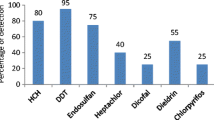Abstract
Wild birds are exposed to insecticides in a variety of ways, at different dose levels and via multiple routes, including ingestion of contaminated food items, and dermal, inhalation, preening, and embryonic exposure. Most poisoning by insecticides occurs as a result of misuse or accidental exposure, but intentional killing of unwanted animals also occurs. In this study, we investigated insecticides in the gastric contents of dead wild birds that were suspected to have died from insecticide poisoning based on necropsy. The wild birds were found dead in various regions and locations such as in mountains, and agricultural and urban areas. A total of 182 dead wild birds of 27 species were analyzed in this study, and insecticide residue levels were determined in 60.4 % of the total samples analyzed. Monocrotophos and phosphamidon were the most common insecticides identified at rates of 50.0 % and 30.7 % of the insecticide-positive samples, respectively. Other insecticides identified in dead wild birds included organophosphorous, organochlorine and carbamate insecticides. However, there was limited evidence to conclusively establish the cause of death related to insecticides in this study. Nevertheless, considering the level of insecticide exposure, it is speculated that the exposure was mainly a result of accidental or intentional killing, and not from environmental residue.


Similar content being viewed by others
References
Berny P (2007) Pesticides and the intoxication of wild animals. J Vet Pharmacol Ther 30:93–100
Blakley BR, Skelley KW (1988) Brain cholinesterase activity in animals and birds. Vet Hum Toxicol 30:329–331
Brown P, Charlton A, Cuthbert M et al (1996) Identification of pesticide poisoning in wildlife. J Chromatogr A 754:463–478
Cha ES, Jeong M, Lee WJ (2014) Agricultural pesticide usage and prioritization in South Korea. J Agromedicine 19(3):281–293
Choi JG, Kang HM, Jeon WJ et al (2010) Characterization of clade 2.3. 2.1 H5N1 highly pathogenic avian influenza viruses isolated from wild birds (mandarin duck and Eurasian eagle owl) in 2010 in Korea. Viruses 5(4):1153–1174
Fleischli MA, Franson JC, Thomas NJ, Finley DL, Riley W (2004) Avian mortality events in the United States caused by anticholinesterase pesticides: a retrospective summary of National Wildlife Health Center records from 1980 to 2000. Arch Environ Contam Toxicol 46:542–550
Goldstein MI, Lacher TE, Woodbridge B et al (1999) Monocrotophos-induced mass mortality of Swainson’s Hawks in Argentina, 1995–96. Ecotoxicology 8:201–214
Gupta PK (2011) Epidemiological studies of anticholinesterase pesticide poisoning in India. In: Satoh T, Gupta RC (eds) Anticholinesterase pesticides: metabolism, neurotoxicity, and epidemiology. Wiley, Hoboken, pp 417–431
Hill EF, Fleming WJ (1982) Anticholinesterase poisoning of birds: field monitoring and diagnosis of acute poisoning. Environ Toxicol Chem 1:27–38
Jeyaratnam J (1990) Acute pesticide poisoning: a major global health problem. World Health Stat Q 43(3):139–144
Kang HM, Jeong OM, Kim MC et al (2010) Surveillance of avian influenza virus in wild bird fecal samples from South Korea, 2003–2008. J Wildl Dis 46(3):878–888
Kim MK, Yun SJ, Kim DG, Bong YH, Kim H, Jang JH, Chung GS (2008) Determination of pesticides in dead wild birds in Korea (in Korean). Korean J Vet Res 48:131–137
Ko KY, Shin JY, Kim DG et al (2014) Determination of organophosphorus pesticides in stomach contents of postmortem animals by quechers and gas chromatography. J Anal Toxicol 38:667–671
Kwon YK, Wee SH, Kim JH (2004) Pesticide poisoning events in wild birds in Korea from 1998 to 2002. J Wildl Dis 40:737–740
Lee DP, Honda K, Tatsukawa R, Won PO (1989) Distribution and residue level of mercury, cadmium and lead in Korean birds. Bull Environ Contam Toxicol 43(4):550–555
Mineau P (2002) Estimating the probability of bird mortality from pesticide sprays on the basis of the field study record. Environ Toxicol Chem 21:1497–1506
Peshin SS, Srivastava A, Halder N, Gupta YK (2014) Pesticide poisoning trend analysis of 13 years: a retrospective study based on telephone calls at the National Poisons Information Centre, All India Institute of Medical Sciences, New Delhi. J Forensic Leg Med 22:57–61
Quick MP (1982) Pesticide poisoning of livestock: a review of cases investigated. Vet Rec 111:5–7
Reece RL, Handson P (1982) Observations on the accidental poisoning of birds by organophosphate insecticides and other toxic substances. Vet Rec 111:453–455
Sheffield SR, Sullivan JP, Hill EF (2005) Identifying and handling contaminant-related wildlife mortality/morbidity. In: Braun CE (ed) Techniques for wildlife investigations and management. The Wildlife Society, Bethesda, pp 213–238
Sheffield SR, Sullivan JP, Hill EF (2012) Identifying and handling contaminant-related wildlife mortality or morbidity. In: Silvy N (ed) Wildlife techniques manual, 7th edn. John Hopkins University Press, Baltimore, pp 154–180
van der Hoek W, Konradsen F (2005) Risk factors for acute pesticide poisoning in Sri Lanka. Trop Med Int Health 10:589–596
Van Dyk JS, Pletschke B (2011) Review on the use of enzymes for the detection of organochlorine, organophosphate and carbamate pesticides in the environment. Chemosphere 82:291–307
Wilkowska A, Biziuk M (2011) Determination of pesticide residues in food matrices using the QuEChERS methodology. Food Chem 125:803–812
Won PO (1983) Bird population in the Nakdong estuary-Assessment of ecological impact of Nakdong estuary barrage and land reclamation Project. Theses Collect Kyung Hee Univ 12:67–84 (in Korean)
Woo HJ, Yoon MB (1989) Wild birds of Korea. Academic Press, Seoul, pp 10–12 (In Korean)
Yeh JY, Kim HJ, Nah JJ et al (2011) Surveillance for West Nile virus in dead wild birds, South Korea, 2005–2008. Emerg Infect Dis 17:299–301
Acknowledgments
We thank the staff of the Avian Disease Division at the Animal and Plant Quarantine Agency (QIA). This research was supported by a grant from the Animal and Plant Quarantine Agency, the Ministry of Agriculture, Food and Rural Affairs of the Republic of Korea.
Author information
Authors and Affiliations
Corresponding author
Rights and permissions
About this article
Cite this article
Kim, S., Park, MY., Kim, HJ. et al. Analysis of Insecticides in Dead Wild Birds in Korea from 2010 to 2013. Bull Environ Contam Toxicol 96, 25–30 (2016). https://doi.org/10.1007/s00128-015-1688-0
Received:
Accepted:
Published:
Issue Date:
DOI: https://doi.org/10.1007/s00128-015-1688-0




